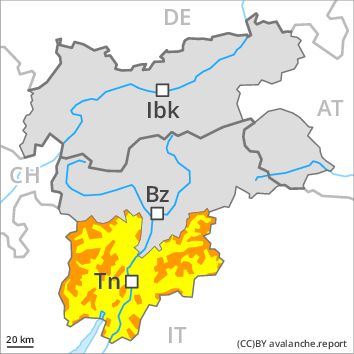Regions
Latemar, Southern Adamello, Primiero - Pale di S. Martino, Adamello - Presanella, Prealps, Northern Brenta - Peller, Cembra Valley, Bondone and Stivo, Vallarsa, Western Nonsberg Alps, Folgaria - Laverone, Southern Brenta, Fassa Valley, Sole, Pejo and Rabbi, Southern Lagorai, Ledro Valley, Northern Lagorai, Maddalene, Paganella, Marzola - Valsugana, Pine' - Mocheni Valley

Danger level
Danger Level 3 - Considerable above the treeline
Danger Level 2 - Moderate above the treeline
Avalanche Problem
Wind-drifted snow above the treeline, N-NE-E-SE-S-SW-W-NW

Slight increase in danger as a consequence of the snowfall.
As a consequence of fresh snow and a strong southwesterly wind, further wind slabs will form as the day progresses, in particular in gullies and bowls, and behind abrupt changes in the terrain at high altitudes and in high Alpine regions in all aspects. Even single winter sport participants can release avalanches, including large ones. The avalanche prone locations are barely recognisable because of the poor visibility.
Avalanches can in isolated cases be released in the old snowpack. Weak layers in the old snowpack can be released in isolated cases in particular at transitions from a shallow to a deep snowpack. Whumpfing sounds and the formation of shooting cracks when stepping on the snowpack indicate the danger.
Snowpack
dp 6: cold, loose snow and wind
Over a wide area 5 to 10 cm of snow. will fall. The strong wind will transport the snow. The fresh snow and wind slabs are lying on soft layers in all aspects. In some cases the various wind slabs have bonded still only poorly with each other and the old snowpack. The snowpack will be subject to considerable local variations. Large-grained weak layers exist in the old snowpack in particular on steep shady slopes.
Tendency
Slight increase in danger of moist avalanches as a consequence of solar radiation.
Regions
Sexten Dolomites, Eastern Pfunderer Mountains, Durreck Range, Val Müstair Alps, Western Rieserferner Mountains, Langtaufers, Western Deferegger Alps, Schnals Ridge, Ortler Range, Southern Stubai Alps, Ulten Valley, Southern Zillertal Alps and High Tauern, Eastern Nonsberger Alps, Saldurn-Mastaun Ridge, Northern Dolomites of Fiemme, Texel Mountains, Gröden Dolomites, Sarntal Alps, Prags Dolomites, Western Pfunderer Mountains

Danger level
Danger Level 3 - Considerable above 2200m
Danger Level 2 - Moderate above 2200m
Avalanche Problem
Wind-drifted snow above 2200m, N-NE-E-NW

Slight increase in danger as a consequence of the snowfall.
As a consequence of fresh snow and a strong southwesterly wind, further wind slabs will form as the day progresses, in particular in gullies and bowls, and behind abrupt changes in the terrain at high altitudes and in high Alpine regions in all aspects. Single winter sport participants can release avalanches in some places. The avalanche prone locations are barely recognisable because of the poor visibility.
Avalanches can in isolated cases be released in the old snowpack. Weak layers in the old snowpack can be released in isolated cases in particular at transitions from a shallow to a deep snowpack. Whumpfing sounds and the formation of shooting cracks when stepping on the snowpack indicate the danger.
Snowpack
dp 6: cold, loose snow and wind
Over a wide area 5 to 10 cm of snow. will fall. The strong wind will transport the fresh and old snow. In some cases the various wind slabs have bonded still only poorly with each other and the old snowpack. The snowpack will be subject to considerable local variations. Large-grained weak layers exist in the old snowpack in particular on steep shady slopes.
Tendency
As the snowfall becomes more intense the prevalence and size of the avalanche prone locations will increase during the course of the night. Friday: Slight increase in danger of moist avalanches as a consequence of solar radiation.
Regions
Western Verwall Mountains, Eastern Verwall Mountains, Silvretta, Samnaun Mountains, Northern Oetz and Stubai Alps, Western Tuxer Alps, Eastern Tuxer Alps, Western Kitzbühel Alps, Eastern Kitzbühel Alps, Glockturm Range, Weißkugel Range, Gurgler Range, Central Stubai Alps, Northern Zillertal Alps, Allgäu Alps, Venediger Range, Eastern Lechtal Alps - Ammergau Alps, Mieming Mountains, Eastern Rieserferner Mountains, Karwendel Mountains, Glockner Range, Eastern Deferegger Alps, Brandenberg Alps, Wilder Kaiser Mountains - Waidring Alps, Schober Mountains, Lienzer Dolomites, Western Lechtal Alps, Central Lechtal Alps, Grieskogel Mountains

Danger level
Danger Level 2 - Moderate above 2200m
Danger Level 2 - Moderate above 2200m
Avalanche Problem
Wind-drifted snow above 2200m, N-NE-NW
Wet snow above 2200m, N-NE-E-SE-S-SW-W-NW

Wind slabs at high altitude. Wet and gliding snow require caution.
As a consequence of a moderate to strong wind from southerly directions, mostly small wind slabs will form. The somewhat older wind slabs of the last few days remain in some cases prone to triggering in particular on very steep shady slopes above approximately 2200 m. The fresh and somewhat older wind slabs can be released by a single winter sport participant in some cases. The avalanche prone locations are to be found in particular adjacent to ridgelines and in gullies and bowls in northwest to north to northeast facing aspects. At elevated altitudes the avalanche prone locations are more prevalent. In the regions neighbouring those that are subject to danger level 3 (considerable) and in the regions exposed to heavier precipitation the avalanche danger is higher.
In addition there is a danger of gliding avalanches and moist snow slides. This applies in particular on steep sunny slopes and on steep grassy slopes.
Snowpack
dp 6: cold, loose snow and wind
dp 3: rain
The wind slabs of the last few days have settled a little. Some snow will fall from the afternoon in particular along the border with Vorarlberg and along the border with South Tyrol,, also in the Schober Mountains and in the Glockner Range. The southerly wind will transport the fresh and old snow. Low and intermediate altitudes: Some rain will fall in some localities. The snowpack will be subject to considerable local variations.
Outgoing longwave radiation during the night will be severely restricted over a wide area.
Tendency
Slight increase in avalanche danger as a consequence of the precipitation.



